The Intriguing World of White Geode Crystals
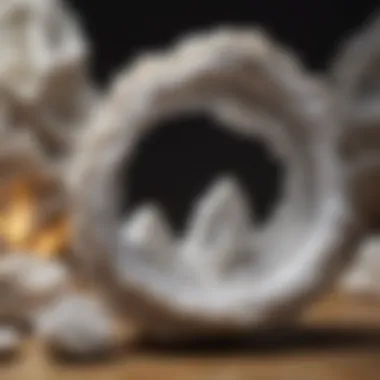
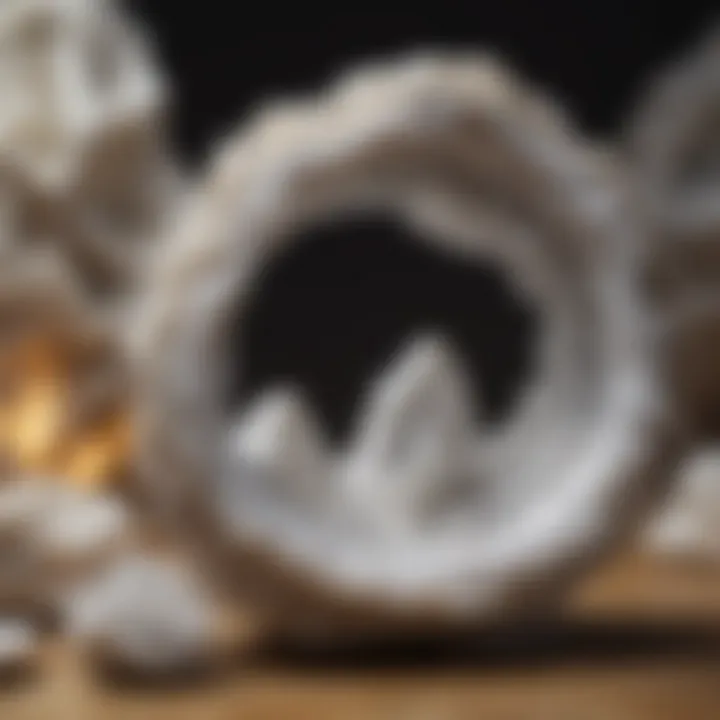
Intro
White geode crystals, often overlooked in the vast expanse of mineralogy, offer a unique glimpse into the earth's intricate tapestry. These natural wonders form in concealed cavities, where mineral-rich solutions deposit crystals over time, creating stunning interiors that captivate the imagination. Whether you’re a seasoned collector or just someone drawn to their beauty, understanding white geode crystals enhances our appreciation of these remarkable formations.
History and Origins
Overview of Collectibles, Rocks, and Fossils
In terms of geological collectibles, white geodes stand out as a magnificent choice. Initially, they were simply seen as rocks, but as people's interest in geology grew, so too did the fascination with these hollow realms. Each geode carries a story, encapsulating millions of years of geological processes.
Geodes can range from the size of a marble to that of a basketball, and their outer layer is typically a rough rock or stone. The interiors, however, reveal a delightful surprise; hundreds to thousands of sparkling crystals, which can vary in type based on the minerals that were deposited. Among these, white geodes often feature quartz crystals that reflect light beautifully, making them timeless treasures.
Historical Significance and Cultural Impact
Historically, white geodes have held significant places in various cultures. They were often thought to be protective amulets, believed to harness spiritual energies. Ancient civilizations, like the Egyptians and Greeks, attributed mystical properties to these crystals, using them in rituals and as talismans. Interestingly, the Greeks referred to quartz as "krustallos," which translates to "frozen ice" — a nod to their belief that crystals were ice that had frozen forever.
"Crystals are the embodiment of time; they are the natural reflections of the earth’s history."
Not just relegated to carelessly laying about, these geodes became symbolic representations within various spiritual practices. Many modern-day enthusiasts continue this tradition, using white geodes for meditation and healing purposes. They are often placed in living spaces to promote tranquility and attract positive energy.
Identification and Classification
Guide to Identifying Rocks and Fossils
When it comes to spotting a white geode, there are specific traits to look for. The exterior can seem quite nondescript, often resembling a rock or stone. Here are some tips:
- Weight: White geodes tend to have a surprising heft due to the crystalline structures inside.
- Texture: The exterior surface may be bumpy or irregular. Feel the surface; it should feel rough but sturdy.
- Color Variation: Although primarily white, some geodes may have tinges of gray or slightly off-white, revealing clues about the minerals within.
- Light Test: If one can access a light source, shining a light through a geode can help to spot the crystals inside.
Common Types and Variations
White geodes are primarily composed of quartz crystals. However, some unique variations exist:
- Calcite Geodes: While primarily white, some contain crystalline calcite, giving a different sheen and texture.
- Amethyst Inclusion: Occasionally, white geodes will capture pockets of amethyst, creating a stunning contrast.
- Selenite: This fibrous sulfate mineral, although more transparent, can form within white geodes and enhance the internal shine.
In essence, white geodes serve as portals into the history of our planet, tantalizing those who unearth them with their beauty and significance. Intrigued collectors can find not just crystals but stories wrapped in each geode, waiting to be explored.
Prelims to White Geode Crystals
In the vast universe of geological wonders, white geode crystals stand out as captivating entities, pulling in rock and fossil collectors with their unique formations and inherent beauty. Understanding these crystals is not just about admiring their aesthetics; it also involves grasping their significance in both scientific and cultural spheres. The importance of white geode crystals lies in their multifaceted nature, exhibiting geological processes that speak to the Earth's history, while also resonating deeply within various cultural narratives.
Definition and Characteristics
White geodes are essentially hollow rock formations lined with crystal formations on their inner surfaces. Unlike your regular rocks, these geodes create a world of crystalline beauty hidden beneath their rough, often unassuming exteriors. Typically, the crystals forming inside are composed mainly of quartz, but they can also include other minerals like calcite or amethyst. Visually, white geodes can range from opaque to translucent, showcasing glimmering quartz crystals when cut open. One striking characteristic of white geodes is their aesthetic versatility; whether placed on a mantel or among a collection, they capture the imagination and provoke curiosity.
Some notable features of white geodes include:
- Shape and Size Variability: They can appear in various shapes, from spherical to elliptical, and can range significantly in size.
- Inner Crystal Structures: The arrangement of crystals may vary, exhibiting different shades of white, from pristine to slightly cloudy.
- Surface Textures: The exterior surface of a geode can often be rough or rugged, hiding the delicate crystals within.
Geological Formation Process
The process behind the formation of white geodes is a fascinating interplay between geological activity and time. Geodes typically begin as bubbles in volcanic rocks or as cavities in sedimentary layers, slowly filling with mineral-rich solutions. Over eons, these solutions seep into the cavity's interior, facilitating crystal growth through evaporation and cooling processes.
In simpler terms, it’s like waiting for dough to rise; you need the right ingredients and time to achieve that glorious, airy result. Ultimately, as the minerals slowly crystallize against the cavity walls, a stunning inner landscape emerges, illustrating the beauty of nature's handiwork.
To put this into perspective, consider the following steps of formation:
- Cavity Creation: Begins with volcanic activity or sedimentary processes.
- Mineral Solution Infiltration: Mineral-rich fluids fill the cavity.
- Evaporation and Cooling: These fluids evaporate or cool, leading to crystal growth.
- Formation of Inner Crystals: Over a prolonged period, visually striking quartz crystals take shape.
"The journey of a geode from a simple rock to a magnificent crystalline structure speaks volumes about the patience intrinsic to nature’s processes."
Thus, white geode crystals are not just geological artifacts but also time capsules, encapsulating millions of years of Earth’s geological history. These crystals serve as a bridge between science and the emotional resonance many collectors find in them, making the exploration of their essence all the more compelling.
Types of Geodes
Understanding the types of geodes is crucial for anyone diving deep into the world of white geode crystals. Diversity among geodes not only broadens appreciation for these formations but also enhances the collecting experience. Knowing the different types enables collectors to identify and select specimens that resonate with their personal tastes and needs.
Common Varieties of Geodes
Geodes come in various shapes and sizes, often influenced by their geological surroundings. Here are a few common varieties:
- Quartz Geodes: Perhaps the most recognized type, quartz geodes are like nature’s treasure chests. Inside, they often contain sparkling quartz crystals that refract light beautifully.
- Amethyst Geodes: With their violet-hued crystals, amethyst geodes are adored for their striking aesthetics and purported calming properties. These are popular among both collectors and those with a love for metaphysical healing.
- Calcite Geodes: These geodes may appear unassuming on the outside, but crack them open, and you might discover lustrous calcite crystals that can take on various shades, including clear, yellow, and even pink.
- Agate Geodes: Agate geodes are often recognized by their colorful banding. The outer layer is usually made of agate, while the inside can contain quartz crystals or other minerals.
Each of these varieties showcases unique textures and colors, catering to different preferences within the collector community. By exploring these common types, enthusiasts can also appreciate the geological diversity that contributes to their formation.
Distinctive Features of White Geodes
White geodes stand out among other types due to their subtle elegance and purity. Their defining features include:
- Coloration: Unlike more vibrantly colored geodes, white geodes often offer soft, milky or translucent surfaces. This makes them versatile for various decor styles.
- Crystal Clarity: Many white geodes contain clear quartz crystals, which can create a beautiful contrast against the white exterior. This clarity allows for the interplay of light, showcasing an ethereal quality.
- Texture Variations: When you touch a white geode, the smoothness or roughness can vary significantly. Some have a glassy finish, while others might be more rugged, adding to their tactile allure.
- Symbolic Value: In many cultures, white crystals are viewed as symbols of purity and clarity. Collectors and spiritual enthusiasts alike often seek them for their supposed energy properties and aesthetic appeal.
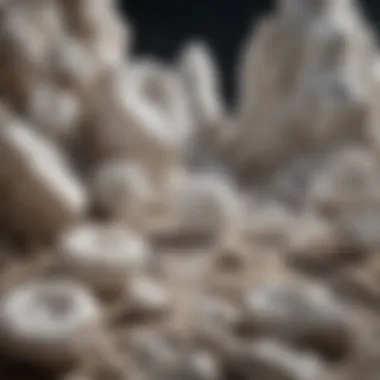
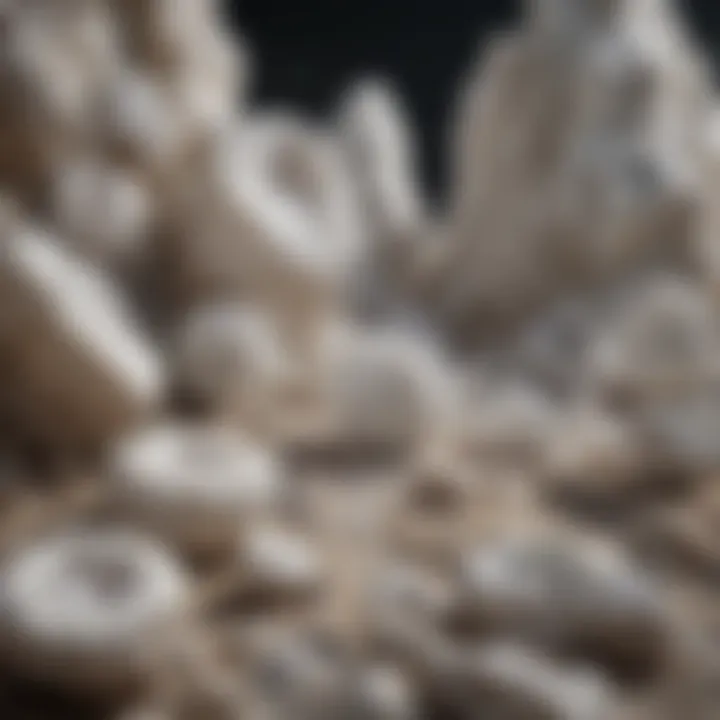
"White geodes encapsulate a rare beauty that bridges the gap between the earthly and the ethereal, making them a coveted find for anyone serious about their collection."
Geological Context
The geological context of white geode crystals is not just about their location but also about how these crystals intertwine with natural processes over time. Understanding the environment where white geodes form helps rock and fossil collectors appreciate their beauty and significance deeply. Geodes are essentially hollow rock structures often lined with crystals, and their formation is a testament to nature's artistry. This section aims to illuminate the layers behind white geodes, offering insight into their origin and distribution.
Geographical Distribution
White geodes are found in various locations around the world, with some regions being particularly fruitful. For collectors, knowing where to find these stunning samples is crucial. Here are some key areas known for their abundance of white geodes:
- United States: The states of California, Arizona, and Nevada harbor some vivid specimens of white geodes, often formed within volcanic ash beds.
- Brazil: Brazil is renowned for its large geodes, particularly those of amethyst; however, it also produces a plethora of white varieties.
- Mexico: The regions near the Mexican plateau are rich in geodes, providing vast opportunities for collectors looking to add to their collections.
These locations not only showcase a rich diversity of minerals but also varying geological processes that contribute to the creation of white geodes. Many elements play a role in their distribution, including volcanic activity, mineral-rich waters, and the age of the surrounding rocks.
Stalactite and Stalagmite Relation
When discussing geodes, the connection to stalactites and stalagmites often comes up. Stalactites hang from the ceilings of caves, while stalagmites rise from the ground. Both formations signify the dripstone process, where mineral-rich water percolates into cave systems over time. This slow process is very similar to how white geodes form within earth’s crust.
The significance of this relationship is twofold:
- Formation Processes: Just as stalactites and stalagmites build layer upon layer, white geodes develop through a gradual process of mineral precipitation. This constant metered flow of water allows crystals to grow over thousands of years, leading to the unique formations we see today.
- Environmental Indicators: The presence of geodes, stalactites, and stalagmites often signals specific geological conditions, such as acidity levels and mineral saturation in the water. Collectors can use this information as indicators of suitable habitats for future explorations.
"The world of geodes and their geological processes reflects a silent history, revealing nature's hidden hand in crafting landscapes that captivate both the eye and the mind."
The Science Behind White Geodes
When we talk about white geode crystals, it’s vital to scratch below the surface, literally and figuratively. The science behind these striking formations offers insights into their mineral content and the intricate processes that lead to their growth. This understanding is not just for the academics; it serves any collector who wishes to appreciate their pieces beyond just visual appeal.
Mineral Composition
White geodes are often comprised predominantly of quartz, with a certain blend of minerals that contribute to their unique aesthetics and properties. Quartz itself is silicon dioxide (SiO₂), a versatile mineral commonly found in many types of rocks. Within the realm of white geodes, the purity of quartz plays a significant role in their appearance. You often find various inclusions—like iron, clay, or calcite—that can influence both the color and the clarity of the crystals.
- Silica Content: This is the primary component, providing that sparkling charm.
- Mineral Inclusions: The little surprises within can add character. Some geodes contain iron oxide, which may give them hints of color such as yellows or reds.
- Pore Space: The empty spaces inside offer room for crystal growth and add to the aesthetic intrigue.
The exact mineral composition can vary greatly depending on where the geode formed, thus affecting its overall value as a collector's item. Collectors should be aware that the more unique or rare the mineral composition, the higher the potential worth of the geode.
Crystal Growth Mechanisms
The formation of crystals within white geodes is a complex process, akin to a slow dance between time and natural conditions. At its core, crystal growth is determined by temperature, pressure, and the chemical environment. Here’s a closer look at how it unfolds:
- Nucleation: Initially, minuscule particles begin to coalesce, marking the first step in crystal formation. This process can take years, sometimes decades, depending on the environmental conditions.
- Growth Phases: As mineral-rich water seeps into the geode, it promotes the growth of quartz crystals. The rate at which they grow relies heavily on temperature; warmer environments can accelerate growth, while cooler temperatures often slow it down.
- Saturation: When the mineral-laden water saturates, crystals grow outward from the initial nucleation point, creating the impressive formations seen upon cracking open a geode.
Understanding these mechanisms deepens the appreciation for these geological forms. The next time a collector admires a polished white geode, there’s a story beneath the surface that illustrates a rich history of mineral evolution.
"White geodes do not just hold crystals; they hold time, a timeline shaped by unique environmental interactions."
In summary, the science behind white geodes is a blend of mineral composition and crystal growth mechanisms, crucial for collectors and enthusiasts alike. By grasping these concepts, one can develop a more profound connection to these beautiful geological formations.
White Geodes in Cultural Practices
The role of white geodes in various cultural practices is a fascinating intersection of natural history and human experience. These remarkable formations convey not just geological beauty, but also a deep cultural relevance that spans across centuries and civilizations. White geodes are often associated with healing, spirituality, and artistic expression. Their unique properties and striking aesthetics make them valuable in various traditions, enhancing our understanding of both our planet and ourselves.
Historical Significance
Throughout history, white geodes have captivated different cultures. Ancient civilizations, such as the Egyptians and Greeks, believed that crystals possessed special energies. They utilized various gemstones, including white stones, in their rituals and decorative arts. The natural beauty and intriguing internal structures of these geodes likely inspired early artists and architects. The Egyptians, in particular, incorporated chalcedony and other white stones into their jewelry and burial artifacts, representing purity and light.
In more recent times, cultures have continued to embrace geodes for their purported metaphysical properties. For example, in the early 20th century, the New Age movement began popularizing crystals as tools for healing and meditation. White geodes were no exception, often touted for their ability to promote clarity and peace of mind. Collectors and practitioners alike sought these crystals for their calming essence, tying together both the historical and modern-day importance of white geodes.
Mythology and Folklore
Mythology often takes its cues from the wonders of the natural world, and white geodes are no exception. Various cultures have woven tales around these crystals, attributing mystical qualities and powers to them. In certain indigenous traditions, white stones were seen as a direct connection to the spiritual realm. They were believed to allow communication with ancestral spirits, serving as a bridge between the earthly and spiritual worlds.
In some folklore, white geodes were associated with transformation and renewal. For instance, it was said that carrying a geode could help one let go of negative energies and embrace personal growth. This idea aligns closely with the properties attributed to quartz, with many believing that white geodes enhance the mind's capacity to focus, promoting mental clarity.
"Crystals are not just stones; they carry the weight of centuries of belief and tradition. White geodes, in particular, reflect an enduring search for light and understanding."
Additionally, stories of creation often feature stones and crystals, positioning them as elemental forces in the universe's unfolding. The white color, symbolizing purity and new beginnings, ties back to various creation myths, reinforcing the significance of white geodes in these narratives. The inclusion of white geodes in cultural practices underlines their dual role as both ornamental objects and symbols of deeper meanings within human consciousness.
As rock and fossil collectors delve into the ethos of these geodes, they not only appreciate their geological formation but also engage with the rich tapestry of human beliefs that have evolved alongside them. Understanding the cultural significance provides a fuller picture of what white geodes represent, echoing the intertwining of nature, art, and spirituality throughout history.
Metaphysical Properties
The study of metaphysical properties of white geode crystals touches on several intriguing elements that go beyond their physical appearance. Though these crystals are often admired for their stunning design and aesthetics, the realm of metaphysics attributes them with significant benefits and considerations that can enhance one's emotional and spiritual well-being. A close look at these attributes reveals why they have garnered interest not just among collectors but also enthusiasts seeking guidance and healing.
Healing Uses
White geode crystals are often regarded as tools for healing in various practices. Their unique structure, with hollow chambers filled with crystals, is believed to embody a calming energy that fosters clarity and balance. Given their soothing aura, these crystals are frequently incorporated into meditative practices. Individuals using white geodes report feelings of tranquility and grounding, especially when placed in areas like the home or workspace.
"White geodes, with their comforting energies, can be the perfect companion during meditation or therapy."
Some practitioners suggest specific healing uses that include:
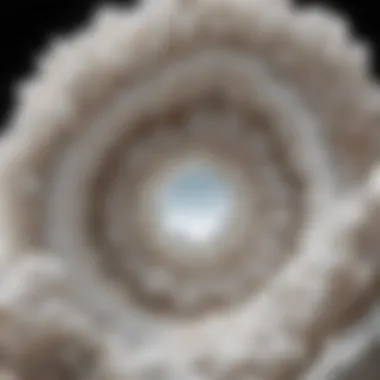
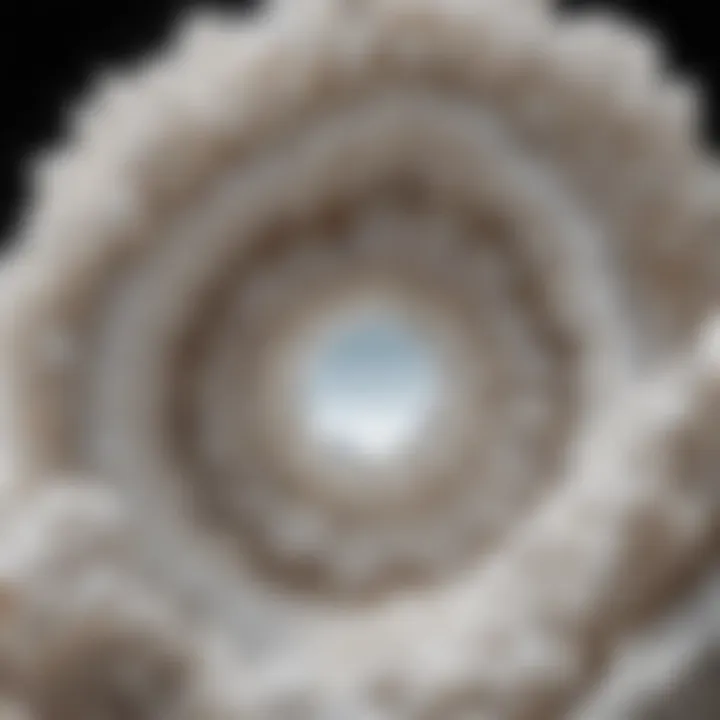
- Stress Relief: Many users believe that having white geode crystals nearby can help alleviate stress and anxiety.
- Emotional Healing: These geodes are often seen as allies for those needing to process emotional wounds or traumas, providing a nurturing energy.
- Enhanced Intuition: By fostering a clear mind, white geodes may support inner wisdom and intuition.
When one chooses to incorporate white geode crystals into their healing rituals, it is essential to approach them with intention and respect. Whether through holding them during meditation, placing them in a sacred space, or simply carrying a small piece with you, awareness of their energy is key in maximizing their healing properties.
Spiritual Significance
Diving deeper, white geodes also hold a substantial spiritual significance. The nature of geodes—forming from the gas bubbles trapped in volcanic rock—makes them symbolic of transformation. This aspect resonates with many who view life's journey as ever-evolving. Collectors and practitioners often keep these crystals for energizing spiritual practices, as they are thought to create a bridge between the material and spiritual realms.
The spiritual significance can also be highlighted in various ways:
- Chakra Balancing: Many people associate white geodes with the crown chakra, enabling a connection to higher consciousness and spiritual insight.
- Protection: These crystals are sometimes regarded as protective stones, standing guard against negative energy or ill will.
- Manifestation: By focusing on one's desires while holding a white geode, some believe it helps in the manifestation of goals and dreams, supporting the Law of Attraction principles.
In summary, diving into the metaphysical properties of white geode crystals uncovers a rich tapestry of healing and spiritual significance. They are among the few stones that encompass both earthy beauty and profound depth, resonating with a range of users, from casual collectors to committed practitioners.
Collecting White Geode Crystals
When it comes to collecting white geode crystals, it’s not just a hobby; it’s a journey into the heart of geological wonder. Understanding the nuances of this pursuit is crucial for anyone looking to truly appreciate these striking formations. White geodes, with their unique characteristics and beautiful interiors, often beckon collectors due to their aesthetic appeal and the stories they hold within.
Proper Identification Techniques
Before diving into the collection process, proper identification of white geodes is paramount. It’s easy to get excited about a potential find, but knowing what you’re looking at can save you from tossing your hard-earned money down the drain on something misrepresented. Here are some practical tips:
- Visual Inspection: Look for the exterior texture of the geode. Genuine white geodes often have a rough, bumpy surface, rather than a smooth one. An authentic geode will look like a rock from the outside, hiding its beauty inside.
- Size Matters: Typical sizes for white geodes can vary, but their diameter often ranges from just a few centimeters to several tens of centimeters. If it’s visibly too big or too small for a geode, it might be worth second-guessing.
- Tap It Lightly: By gently tapping on a suspected geode with a small hammer or rock, you may hear a hollow sound if you’ve got a winner. This hollow sound is a telltale sign that there’s a cavity within, filled with stunning crystals.
- Check for Crystals Inside: If possible, try to glimpse inside before purchasing. A glimpse of white crystalline structures or drusy formations can signal that it’s indeed a geode.
"The thrill of the hunt for white geodes can turn into a rewarding experience, but only if you approach it with knowledge and care."
Knowing how to identify these natural treasures will help ensure that your collection is both beautiful and authentic.
Setting Up a Collection
Now that you’ve mastered identification, it’s time to look into setting up your collection of white geode crystals. A well-thought-out collection doesn’t happen overnight; it requires planning and care. Here are some essential steps to get you started:
- Determine Your Focus: Decide if you want a broad range of geodes or if you’d prefer to specialize in white geodes alone. Specializing can lead to a more cohesive collection.
- Storage Solutions: Invest in proper storage materials to keep your crystals safe from damage. Shelving units, display cases, and padded storage boxes work well. Keep in mind the importance of not stacking geodes on top of each other, as they can chip easily.
- Document Everything: Consider keeping a collector's journal. Note where and when you found each geode, its price, and any peculiarities about it. This documentation can add to the overall story of your collection and serve as a valuable reference.
- Display with Thought: Arrange your geodes in a display that highlights their beauty. Consider backlighting them to showcase their interior crystals, or organize them by size or shape for an eye-catching effect.
- Participate in Communities: Engage with collectors online or in local clubs to share experiences, trade or acquire new geodes, and learn from others in the field. Platforms like Reddit often have active groups focused on rock and mineral collecting.
Setting up a collection is a personal expression, so let your creativity shine, but always be mindful of how you treat your geodes. They hold the essence of nature and history, deserving of care and respect.
Caring for Geode Collections
Caring for a collection of geodes isn’t just about keeping them looking good; it’s a matter of preserving the integrity of these stunning geological formations for years to come. Collectors often find solace in the beauty and uniqueness of each piece, and understanding how to properly maintain these treasures can enhance their experience. White geode crystals, with their intricate patterns and crystal structures, deserve special attention, especially when considering their potential value and significance.
Cleaning Techniques
Cleaning geodes requires a gentle touch. Using the wrong methods can damage their surface or even their internal structure. Here are a few effective techniques:
- Gentle Washing: Start by rinsing the geodes under lukewarm water. Avoid hot water as it can cause thermal shock. Use a soft-bristled toothbrush to scrub away any dirt, but be cautious around fragile areas.
- Mild Soaps: For tougher stains, consider using a few drops of mild dish soap mixed in water. Again, use a soft brush to clean the crevices without scratching the surface.
- Avoid Harsh Chemicals: Stay clear of bleach or acidic cleaners; they can eat away at the delicate minerals in the rock, altering their color and sheen.
- Dry Properly: Once cleaned, allow the geodes to air dry completely. Drying them in direct sunlight can cause cracking, so it’s better to place them in a shaded area.
By following these cleaning methods, collectors ensure that their white geodes maintain both their beauty and structural integrity, providing a longer-lasting addition to their collection.
Display and Preservation
Once cleaned, displaying geodes properly is key to preserving their condition. Proper display not only protects them from damage but also highlights their natural beauty. Here are some practical tips:
- Use Appropriate Stands: Opt for stands that fit the shape of the geode. Some collectors prefer wooden stands for an earthy aesthetic, while transparent acrylic options can create a floating effect.
- Avoid Direct Sunlight: Displaying geodes in direct sunlight can fade their colors over time. Instead, choose a location with indirect natural light or use artificial lighting designed for showcasing crystals and minerals.
- Temperature and Humidity Control: Keep them in a stable environment. Sudden changes in temperature or humidity can lead to cracking or damage in the crystal formations. Ideally, the atmosphere should be cool, dry, and well-ventilated.
- Regular Checking: Periodically inspect your collection for dust accumulation or signs of damage. Not only does this care keep them looking their best, but it also allows for early detection of any potential issues.
"The way you care for your geodes is a reflection of your appreciation for their natural wonders."
By thoughtfully cleaning and displaying white geode crystals, collectors can not only enjoy their beauty daily but also ensure their geological wonders are preserved for future generations.
Market Value and Trading
Understanding the market value and trading of white geode crystals is essential for both novice and experienced collectors. These crystals are not just beautiful objects; they serve as investment pieces and collectibles that can appreciate in value over time. This section unpacks the elements that influence their worth and where enthusiasts can buy or sell these geological treasures.
Factors Influencing Value
The value of white geode crystals is determined by a multitude of factors, each contributing to their unique market standings. Here are some key considerations:
- Size and Weight: In the world of geodes, bigger is often better. Larger crystals generally fetch a higher price, particularly if they exhibit good internal structure and quality.
- Aesthetic Appeal: The visual charm of a geode draws a buyer in. Factors like shape, clarity, and the presence of striking crystal formations make a significant impact on value.
- Condition: Like any collectible, the state of the geode plays a role. Cracks, chips, or discoloration can diminish value, so pristine examples command higher prices.
- Rarity: Limited availability often leads to increased market value. Certain colors or formations of white geodes may be rarer than others, pushing the price up significantly.
- Provenance: The history behind a geode can also affect its value. If it comes from a well-known location or is associated with a famous geological event, collectors may be willing to pay a premium.
"Every collector knows that the story behind the piece often adds layers of value that surpass the physical attributes themselves."
Buying and Selling Platforms
In today’s digital age, a plethora of platforms exists for buying and selling white geode crystals, making it easier than ever for collectors to find what they seek. Here are some of the most popular avenues:
- Online Marketplaces: Websites like eBay and Etsy provide vast selections and pricing options for all buyers. Here you can find everything from rough specimens to polished pieces, each listed with detailed descriptions and condition metrics.
- Gem and Mineral Shows: Attending local or national shows offers the chance to interact with vendors directly. You can physically inspect the geodes before making a purchase, an advantage over digital-only transactions.
- Social Media Groups and Forums: Platforms like Reddit and specialized Facebook groups cater to collectors, allowing them to network, share insights, and even trade or sell geodes directly.
- Local Rock Shops and Mineral Dealers: Finding a reputable dealer in your area can lead to valuable connections and the chance to see unique specimens not available elsewhere.
Each of these platforms has its strengths and weaknesses, and understanding them can help collectors make informed decisions.
Scientific Research on Geodes
Scientific research surrounding geodes, particularly white geode crystals, is an important avenue of inquiry that deepens our understanding of these mesmerizing geological formations. The study of geodes touches several disciplines, including geology, mineralogy, and even cultural anthropology. It offers insights that extend beyond mere crystal aesthetics, touching on the materials' formation processes, ecological impacts, and their significance in many cultures. For rock and fossil collectors, knowledge gleaned from scientific research enhances appreciation and informs responsible collection practices.
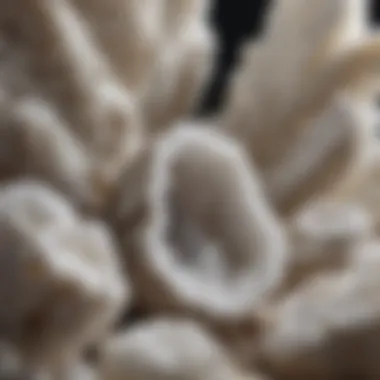
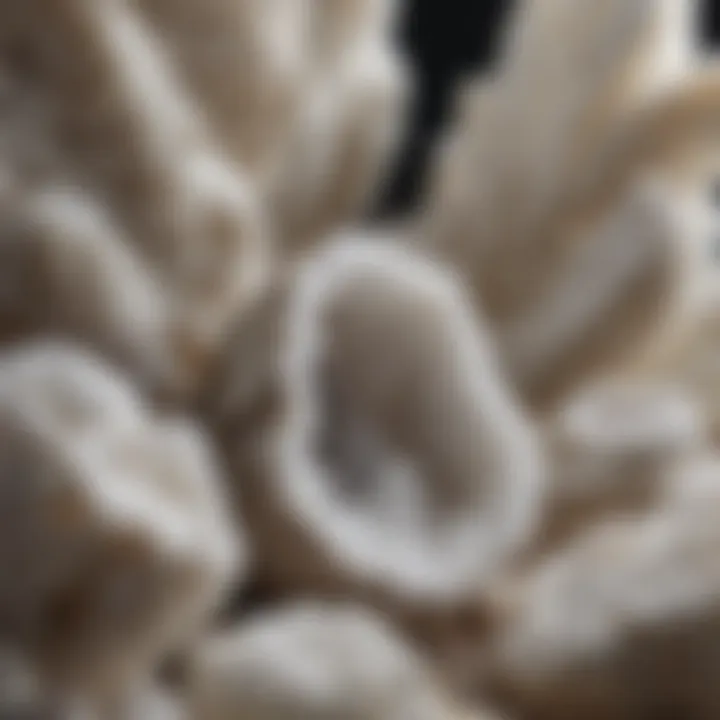
Current Studies and Findings
Recent studies have explored a variety of aspects concerning geodes. Notably, one area of interest is the mineralogical composition of white geodes. Researchers have found that many white geodes are primarily composed of quartz crystals, but they can also contain a mix of calcite or even agate. The crystalline structure within these rocks often reveals a pattern of growth that reflects the geological history of the area.
Here are some key points from recent findings:
- Geochemical Studies: Recent analyses using advanced geochemical techniques have provided insights into the conditions under which these geodes form. Factors such as temperature, pressure, and chemical environment play critical roles in their development.
- Formation Dynamics: Understanding the mechanisms behind geode formation has opened avenues for predicting where geodes are likely to be found. Some studies suggest that specific geological settings, like volcanic environments or sedimentary basins, are hotspots for finding new geode formations.
- Cultural Observations: In some recent anthropological studies, white geodes have been linked to various cultural practices, leading to a fascinating intersection between geology and human history.
"The scientific inquiry into geodes not only satisfies curiosity about their formation but also sheds light on their cultural relevance across civilizations."
Future Research Directions
As the field of geode research continues to evolve, several future directions promise to enrich our understanding further. One avenue for exploration is the environmental impact of geode mining and collection. Sustainability is becoming increasingly vital in geological studies. Potential studies include:
- Sustainability Practices: Investigating sustainable mining approaches may help mitigate negative impacts on ecosystems, ultimately preserving the natural beauty of geodes and their surroundings.
- Enhanced Analytical Techniques: As technology advances, employing more sophisticated analytical tools could offer deeper insights into the molecular structure of geodes. Such research might unlock secrets tied to the geodes’ color variations and crystal growth patterns.
- Interdisciplinary Research: Merging geology with fields like climate science or even psychology could yield new understandings of how these precious formations influence human experiences.
In summary, scientific research on geodes is not merely academic. It informs valuable practices for collectors and enthusiasts while nurturing an appreciation for the natural world. Each study builds on the last, broadening our context for understanding white geode crystals and their exquisite beauty.
Interdisciplinary Perspectives on Geodes
Exploring white geode crystals stretches beyond just their physical beauty or geological significance. The multifaceted nature of these formations invites diverse academic disciplines to converge and provide a richer understanding and appreciation. From the precise world of geology to the expressive realm of art, these crystals serve as a canvas where science and creativity intermingle.
Through a interdisciplinary lens, we gain not only an insight into the geological processes creating these stunning artefacts but also how they influence and inspire various artistic forms. This perspective encourages collaboration, showcasing how geology, art, and anthropology can enrich our understanding of white geodes.
Geology Meets Art
White geodes, characterized by their striking white outer shell and shimmering crystalline interiors, have inspired numerous artists and craftsmen. The connection between geology and art is palpable. Artists often draw inspiration from the intricate patterns and textures of geodes, finding beauty in their natural formations.
A notable example is the use of geode slices in jewelry design. These slices are cut and polished, transforming raw geological materials into wearable art. Designers like Jennifer Meyer create unique pieces that not only flaunt the crystals’ splendor but also tell a story about their origin. Each time a piece is crafted from a white geode, it serves as a bridge between the austere beauty of nature and human creativity.
Furthermore, artists like Anya Gallaccio employ natural materials, including geodes, in their works, highlighting the transient beauty of nature. Her pieces remind us to reflect on the passage of time and the fragility of beauty, much like nature’s own geological processes.
Cultural Anthropology Insights
From an anthropological viewpoint, white geodes are more than mere geological specimens. They are intertwined with cultures around the globe, often associated with various beliefs and practices. In some societies, geodes are considered symbols of protection and power, embodying the Earth’s hidden treasures.
Ethnographic studies reveal that people across cultures have used these stones in rituals, believing they possess cleansing and healing properties. The Apache, for example, see crystals as guides for the soul’s journey, while artisans in various cultures use them in medicine and spiritual practices. These connections offer a glimpse into how humans relate to their environment, interpreting geodes not just as rocks but as vessels of mythos and meaning.
"There’s a sense of wonder that comes from exploring these stones. Each geode tells a story waiting to be uncovered, prompting us to ask, what lies beneath the surface?"
The conversation around white geodes encompasses a tapestry of perspectives. It allows us to link the earth’s history with artistic expression and the richness of cultural narrative, ultimately inviting us to appreciate these crystals for more than their aesthetic allure. As collectors and enthusiasts dive deeper, they find that white geodes embody layers of meaning that connect nature, art, and human experience.
Challenges in Geode Collection
Collecting geodes, particularly white geode crystals, is often perceived as a hobby marked by tranquility and discovery. However, a closer look reveals that this pursuit comes with its own set of challenges that collectors must navigate. Understanding these challenges is crucial for both seasoned collectors and newcomers alike, as it allows them to make informed decisions and contributes to a more sustainable practice. This section will explore the ethical considerations and environmental impacts related to geode collection, shedding light on why it's imperative to tread carefully in this beautiful, yet sensitive, geological realm.
Ethical Considerations
When it comes to collecting white geodes, ethics plays a significant role. Collectors need to consider the sources of their crystals. Well-known geode-rich regions such as Brazil and the United States have areas where collection is regulated. Here are a few important points:
- Respect for Landowners: Always gain permission before collecting on private property. Trespassing not only undermines trust but can also lead to legal consequences.
- Local Communities: Many geode locations hold cultural significance for local communities. It’s essential to engage with and respect these groups. Some collectors advocate fair trade practices to ensure that local economies benefit from the sale of geodes.
- Regulated Areas: In some regions, geode mining is subject to strict regulations to prevent overharvesting. Adhering to these guidelines ensures that geological resources are protected for future generations.
"Collecting without understanding the foundations of ethics is like fishing in a puddle—eventually, the pool runs dry."
By acknowledging these ethical considerations, collectors can uphold a sense of integrity and respect for the environment and the communities that surround it.
Environmental Impacts
Another layer of complexity is the environmental effects linked to geode collection. Harvesting these natural formations at an unsustainable rate can lead to significant ecological repercussions. Here’s a breakdown of the environmental aspects to consider:
- Ecosystem Disruption: Geode mining can disrupt local ecosystems, affecting both flora and fauna. Disturbing these natural habitats can have cascading effects that are often felt long after the mining has ceased.
- Soil Erosion: The physical act of digging and removing geodes can lead to soil instability, making areas prone to erosion. Over time, this can alter landscapes and disrupt sediment flows in nearby water bodies.
- Water Quality: If not managed carefully, the removal processes can lead to sediment runoff, which may pollute nearby water sources. This is particularly concerning in areas where local wildlife depends on these waters for survival.
Taking the time to recognize these impacts not only enhances a collector's appreciation for the natural world but also cultivates a more conscientious approach to geode collection.
In summary, while the allure of white geode crystals can be captivating, collectors must navigate the myriad ethical and environmental challenges that accompany this rewarding hobby. Balancing passion with responsibility ensures that future enthusiasts will also enjoy the beauty that geodes have to offer.
The End
The conclusion of this article serves as a significant focal point by summarizing the journey through the multifaceted nature of white geode crystals. It draws attention to essential elements such as their geological formation, the intricate properties that define them, and their cultural relevance. Understanding these aspects is not just an academic exercise; it provides rock and fossil collectors with a deeper appreciation and context when acquiring or studying these unique geodes.
In terms of benefits, the knowledge gained can enhance both the practical and aesthetic appreciation of white geode crystals. Collectors can make informed decisions about their acquisitions, knowing the geological history and uniqueness of each piece. Moreover, grasping the metaphysical properties attributed to these crystals enriches the experience for those who seek not only beauty in their collections but also a connection to the earth's history and energies.
Summary of Insights
Through the exploration of various sections of the article, we covered a wide range of topics related to white geode crystals. From their geological formation process to their unique aesthetic features, we witnessed how these natural wonders originate deep within the Earth. The distinctive white coloration comes from mineral deposits, and knowing this can inform collectors about the origin and value of their specimens.
Additionally, we examined the broader significance of white geodes in cultural practices and metaphysical beliefs. Historically, these crystals have held a place in various cultures as symbols of purity and transformation. By understanding this cultural context, collectors can appreciate not just the physical attributes of geodes but also their symbolic meanings and historical narratives.
Final Thoughts on White Geode Crystals
To encapsulate, white geode crystals are not mere geological specimens; they are stories etched in time. Their beauty lies not only in their visual allure but also in their rich, complex histories. As collectors, delving into the depths of their nature serves as both a personal journey and a connection to the larger universe of geology and cultural significance.
In a world where the significance of objects often gets lost in modernity, these crystals remind us to pause and reflect on the intricate processes that led to their formation. They could be artifacts of magnificence or portals to enlightenment, depending on how one chooses to engage with them. The depth of their edges and the brilliance of their inner structures beckons collectors to explore beyond the surface.
"Understanding the origins and significance of white geode crystals can deepen your connection to the natural world and enhance your collection's narrative."
By fostering this kind of engagement, a collector not only stands to gather stunning crystals but also echoes the philosophy of stewardship towards our planet, paving the way for a deeper understanding and appreciation of nature's artistry.



